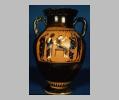| Collection: | Museum of Fine Arts, Boston |
| Summary: | Side A: A girl on a swing. Side B: A winged goddess and men. |
| Ware: | Attic Black Figure |
| Painter: | Attributed to the Swing Painter |
| Attributed By: | J.D. Beazley |
| Context: | Said to be from Ferentino |
| Date: | ca. |
| Dimensions: | H. 0.401 m.; D. 0.264 m. |
| Primary Citation: | |
| Shape: | Panel amphora |
| Beazley Number: | 301521 |
| Period: | Archaic |
Condition:
The colors are well preserved, but there are some chips and spalls.
Decoration Description:
The vessel has a flaring mouth, and a flat and unglazed top. The neck is glazed on the inside to a depth of 5.0 cm. The handles are round, and entirely glazed. The foot is an echinus shape, with rays above. The panels are framed at the sides and the bottom by a thin glaze line, and surmounted by hanging lotuses and lotus buds between glaze lines.
Side A: Iris(?) and Zeus(?) are depicted. The winged female is represented to the right in the archaic running position (knielauf) with her head turned back. In front of her, a bearded male figure raises his hand. To the left are two bearded spectators. Iris wears a belted nebris over a short-sleeved chiton, a necklace, and a fillet in her hair; her skin is white. The male figures wear chitons and himatia.
Side B: A girl is on a swing, with onlookers around her. She sits to the right on a rope swing, the seat of which has been fashioned from a diphros and the ropes of which are suspended from the ornamented border above. Two men watch on each side; all but the closest to her on the right are bearded. The furthest on the right raises his right hand, thumb extended. He is wearing a chlamys, the other men wear chitons and himatia. The girl wears a peplos, necklace, and a fillet in her hair; her skin is white
Beazley (BSA 32 [1931-1932]) suggested that the winged figure on Side A was Iris. Representations of swinging are rare in black figure vase painting, but there is another vase by the Swing Painter (
Collection History:
H.L. Pierce Fund, 1898.
Sources Used:
Other Bibliography:
AA 84 (1969) 71, fig. 2Brooklyn Museum Annual 5 (1963-1964) 11, fig. 3CVA France 10 Paris Bibliothèque Nationale 2 JHS 52(1932) 142

